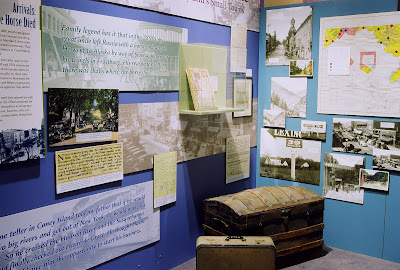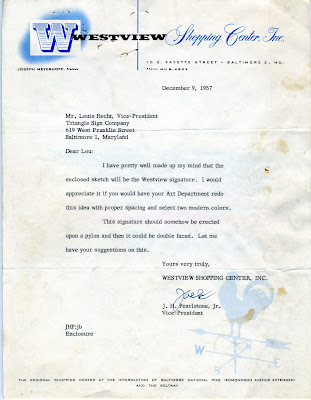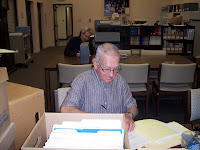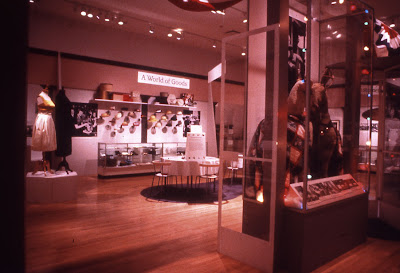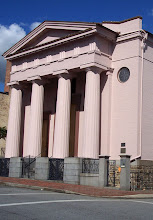Eating Lunch at the JMM
A blog post by Anita Kassof, associate director

If you’ve tooled around our website lately or read our blog, you probably know that we’re gearing up for a major exhibition called Chosen Food, opening in September 2011. Among other things, the exhibition will use the rich material culture of foodways to demonstrate how American Jews use food as an essential mode of cultural communication.
Wait, what?
For those of you not familiar with museum-speak, that last sentence is a fancy way of saying, “You are what you eat.” What we eat—and the way we eat it and with whom—reveals a lot about us. With that in mind, I thought I’d engage in a little clandestine observation of my JMM colleagues at the lunch table. I figured the lunchroom would be fertile ground for discovering whether what we eat and how we talk about food really does say something about us as individuals and as a staff.
 Where the magic happens...and by magic, I mean: lunch.
Where the magic happens...and by magic, I mean: lunch. The work fridge.
The work fridge.So what do we pack in our lunch bags? Rachel usually has something fabulous that she’s cooked up with an odd assortment of kale and mushrooms and Swiss chard from her CSA. Jobi often brings leftovers from some funky eatery in Butcher’s Hill. And then there’s Elena, Queen of Pie. It’s only a slight exaggeration to say that we hired Elena because pie—in all its luscious varieties—was the main topic of conversation at her interview. Karen’s a mixed bag. Either she’ll pull out a container of some homemade kosher delicacy that often involves a soy-based ersatz-meat product, or she’ll microwave up a paper container of noodle soup. As the curator of Chosen Food, Karen should probably know better than to eat reconstituted freeze-dried noodle products but, given her commute, who can blame her?
 Rachel takes full advantage of tomato season - BLT and fried green tomatoes!
Rachel takes full advantage of tomato season - BLT and fried green tomatoes! Jobi munches on some excellent chicken and black bean soft tacos.
Jobi munches on some excellent chicken and black bean soft tacos. Elena rocks her pasta-and-veg.
Elena rocks her pasta-and-veg. Karen and her kosher fare - looking pretty tasty!
Karen and her kosher fare - looking pretty tasty!How we pack our lunches and how we eat them also makes for some amusing observations. Take Barry, for example. He eats a wide variety of heart-healthy food, most of it lovingly packed by his wife, Sandee, into . . . plastic baggies? Okay, I’m not above sticking some baby carrots into a Ziploc, but stew in a bag? No lunch with Barry is complete if I haven’t ribbed him about his next birthday present: an economy size set of Tupperware.
 Barry and his unconventional lunch packaging...is that...pasta salad?
Barry and his unconventional lunch packaging...is that...pasta salad?Esther doesn’t sit down at the table. Standing at the counter, she’s apt to be picking at a salad or cottage cheese (no calories when you’re standing up, after all), and moaning about how she can barely zip her slacks anymore. I think this must be a Jewish Mother thing, because Esther is slim and beautiful and looks about twenty years younger than she should. Maybe it’s just that she’s more comfortable feeding others than feeding herself, and if you’ve ever been the beneficiary of her homemade chocolate cake, you can thank your lucky stars for that.
Sue packs lunch for herself and her mother, who comes to work with her every day, and then they sit down together and eat off of real plates with real cutlery. It’s usually something hot, and often includes cookies or something sweet for dessert. We enjoy Mrs. Miller’s company, I think she enjoys ours, and her presence at the staff lunch table reminds us that, among other things, food is about family.
Then there’s Avi, the man who doesn’t plan ahead. On those occasions when he does stop into the lunchroom to talk—and talk—he’s invariably foodless and looks longingly at others’ plates until they share, or he gives up and makes himself a meal out of whatever leftovers he can scrounge in the refrigerator (usually there are lots of those, happy by-product of meetings and public programs).
 Avi's in luck today - plenty of sweet goodies to sink his teeth into!
Avi's in luck today - plenty of sweet goodies to sink his teeth into!What do we talk about at the table (besides food, that is)? Anything from current movies to kids is fair game. The only topic that we try to stay away from is the conflict in the Middle East, because too many strong opinions can cause indigestion. But everything else goes. Today over lunch, Deb (leftover salad, berry-flavored applesauce), told me that she’d recently seen Food, Inc., the movie about agribusiness and all the horrible things it’s doing to the ecosystem, the small farmer, and our bodies, thereby serving me up a good dose of Jewish guilt with my turkey avocado wrap.
 Deb, "lecturing" Anita about agribusiness.
Deb, "lecturing" Anita about agribusiness.Both the tenor of our conversation and the contents of our lunch sacks vary depending on the day and the season. When our volunteers (mostly retirees) join us at the lunch table, you see a lot more wax paper wrapped sandwiches and cans of V-8, and the conversation tends toward the nostalgic. In the summer, when the building is bursting at the seams with interns (the millennial generation), lunchtime conversation can be raucous. And the quantity of odd ethnic eats rises in direct proportion to the number of interns on the staff. I don’t think most 20-somethings would know what to make of baloney on white.
So, what can we conclude from all this?
For starters, this isn’t a Fortune 500 company. We bring our lunches because, frankly, on a museum salary, who can afford to go out for lunch? Our kitchen isn’t kosher. We’re a diverse group, and even those Jews among us vary widely in our food habits, from no-pork-but-anything-else-goes, to kosher-at-home-but-bring-on-that-bacon-cheeseburger-in-a-restaurant, to vegetarian, to glat kosher. Also, there are a lot of mighty good and inventive cooks among us. I repeat: Esther’s Chocolate Cake.
 The lunch aftermath - but look at all those reusable containers!
The lunch aftermath - but look at all those reusable containers!Most important, though, we eat together. Breaking bread together punctuates our day and sustains us through our battles with uncooperative spreadsheets, building maintenance emergencies, and looming deadlines. Over lunch, we learn something about one another’s non-work selves by talking about our families, recounting our weekend adventures, or swapping recipes. We seem to talk an awful lot about what we eat and don’t eat (don’t even get Jobi started on mayonnaise). Over our noontime meal, we schmooze, we kibbitz, we debate. We nourish ourselves as individuals and as a group. After all, isn’t that what food is all about?
You know, I bet we could do an exhibition about this . . . .
 The author, with the remains of her own lunch.
The author, with the remains of her own lunch.
 Melina hard at work on the “Office Files”
Melina hard at work on the “Office Files” Before the Great Box Shift
Before the Great Box Shift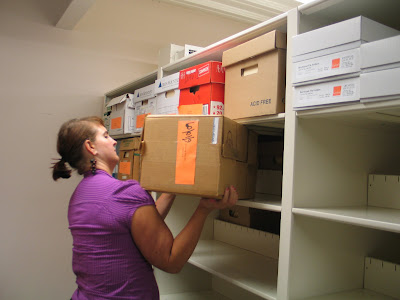 This is what happens when you’re the last intern – you have to move boxes. Thanks Melina!
This is what happens when you’re the last intern – you have to move boxes. Thanks Melina! After the Great Box Shift
After the Great Box Shift Neatly processed and organized BHU archives.
Neatly processed and organized BHU archives.




